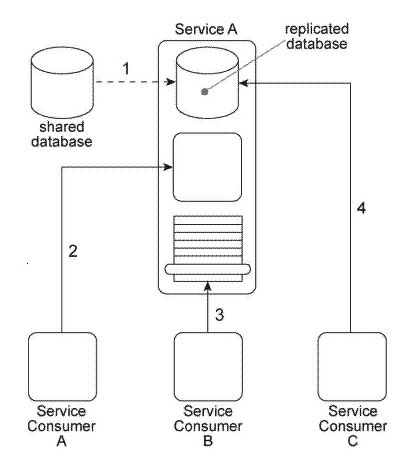Service A is a utility service that provides generic data access logic to a database that contains data that is periodically replicated from a shared database (1) . Because the Standardized Service Contract principle was applied to the design of Service A, its service contract has been fully standardized. The service architecture of Service A is being accessed by three service consumers. Service Consumer A accesses a component that is part of the Service A implementation by invoking it directly (2) . Service Consumer B invokes Service A by accessing its service contract (3) . Service Consumer C directly accesses the replicated database that is part of the Service A implementation (4) . You've been told that the shared database will soon be replaced with a new database product that will have new data models and new replication technology. How can the Service A architecture be changed to avoid negative impacts that may result from the replacement of the database and to establish a service architecture in which negative forms of coupling can be avoided in the future? 
A) The Contract Centralization pattern can be applied to force all service consumers to access the Service A architecture via its published service contract. This will prevent negative forms of coupling that could lead to problems when the database is replaced. The Service Abstraction principle can then be applied to hide underlying service implementation details so that future service consumers cannot be designed to access any part of the underlying service implementation.
B) The Contract Centralization pattern can be applied to force Service Consumer C to access the Service A architecture via its published service contract. This will prevent Service Consumer A from being negatively impacted when the database is replaced in the future.
C) The Standardized Service Contract principle can be applied to force Service Consumer B to comply to the standardized service contract of Service A. As a result, the coupling between Service Consumer B and Service A is reduced. The Logic Centralization pattern can then be applied to position the logic provided by Service A as a primary access point for the database. As a result, the component within the Service A architecture abstracts the proprietary details of the database, thereby shielding Service Consumer A (and any future service consumers) from changes made to the database.
D) None of the above.
Correct Answer:
Verified
Q6: The architecture for Service A displayed in
Q7: Service A is an entity service that
Q8: Our service inventory contains the following three
Q9: It has been confirmed that Policy A
Q10: You are told that in this service
Q12: Service A is a task service that
Q13: When Service A receives a message from
Q14: Service A is a utility service that
Q15: Service A is a task service that
Q16: Service A is an entity service that
Unlock this Answer For Free Now!
View this answer and more for free by performing one of the following actions

Scan the QR code to install the App and get 2 free unlocks

Unlock quizzes for free by uploading documents